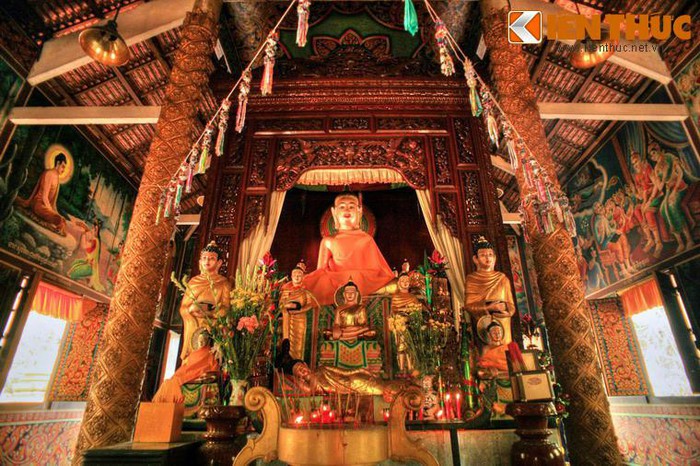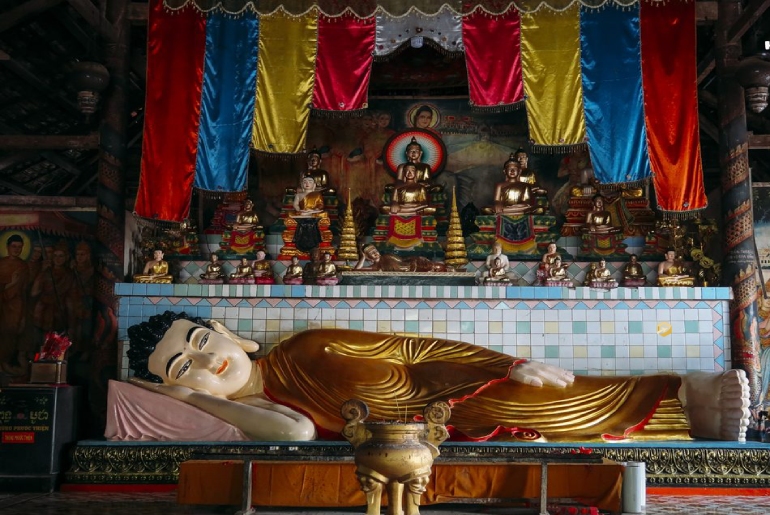Doi Pagoda
1. Overview
Mahatup Pagoda, more popularly known as Bat Pagoda (Chùa Dơi), is one of the most famous and unique spiritual landmarks in Soc Trang province, southern Vietnam. Located just 2 kilometers from the city center, the pagoda is not only a sacred Khmer Buddhist site but also home to thousands of giant fruit bats that roost peacefully in its trees. This rare harmony between nature and spirituality makes Chùa Dơi a must-visit destination for tourists and pilgrims alike.
2. Historical and Cultural Significance
Mahatup Pagoda was originally built in the 16th century by the Khmer ethnic community, who make up a significant part of the population in Soc Trang. The pagoda has stood for hundreds of years as a center of Theravāda Buddhism, the dominant form of Buddhism practiced by Khmer people.
It plays a crucial role in preserving Khmer culture, language, and spiritual traditions. Over the centuries, it has been renovated and expanded but still retains its original religious identity. The temple is also an educational hub where young Khmer boys come to study Pali scriptures and Buddhist teachings.
The unique nickname “Chùa Dơi” (Bat Pagoda) comes from the thousands of fruit bats that naturally inhabit the ancient trees within the pagoda’s grounds. These bats are considered a symbol of good luck by the local people and are strictly protected by the monks and community.
3. Architecture and Design
Mahatup Pagoda features typical Khmer Buddhist architecture, which is richly ornate and symbolic. Notable architectural features include:
-
Multi-tiered, curved roofs with Naga (serpent) carvings guarding the edges.
-
Golden stupas and towers, used to house relics and ashes of monks.
-
Intricately carved wooden doors and windows with motifs of lotus flowers and Buddhist icons.
-
Statues of Buddha and Bodhisattvas in various poses inside the main hall.
-
Bright, colorful murals that depict the life of the Buddha and Jataka tales.
The temple grounds are spacious and lush with large trees, especially giant tropical almond trees, which serve as the habitat for the bats.
4. How to Get There
Chùa Dơi is located in Ward 3, Soc Trang City, about 2 kilometers from the city center. It’s very accessible by:
-
Car or motorbike (15-minute drive from Soc Trang Bus Station)
-
Taxi or bicycle for local exploration
-
Visitors can also join guided tours of Khmer cultural sites, which often include this pagoda.
5. Festivals and Activities
The pagoda hosts a number of traditional Khmer and Buddhist festivals, including:
-
Chol Chnam Thmay (Khmer New Year): Held in April, with festive dances, water rituals, and temple offerings.
-
Sene Dolta Festival: A ceremony to honor ancestors, similar to Vietnam’s Vu Lan.
-
Ok Om Bok Festival: Celebrating the moon and thanking it for a bountiful harvest.
Throughout the year, visitors can also witness:
-
Buddhist chanting and rituals performed by the monks.
-
Educational programs for Khmer youth on Buddhist ethics and language.
-
Volunteer opportunities and donation drives for temple restoration.
6. Tips for Visitors
-
Dress modestly (no shorts or sleeveless shirts).
-
Do not disturb the bats, especially during the day when they rest upside-down in the trees.
-
Avoid loud noises to maintain the peaceful atmosphere.
-
Visit early morning or late afternoon for cooler weather and better chances of seeing the bats in flight.
-
Bring a camera, but be mindful of where photography is allowed.
7. Conclusion
Mahatup Pagoda (Chùa Dơi) is not only a sacred religious site but also a natural sanctuary, where Buddhism and wildlife coexist in harmony. With its deep Khmer cultural roots, stunning architecture, and unique resident bat population, it offers a rare and enriching experience for all who visit. Whether you are a spiritual seeker, a history lover, or simply curious about Vietnam’s diverse culture, Chùa Dơi is an unforgettable stop in the heart of the Mekong Delta.




